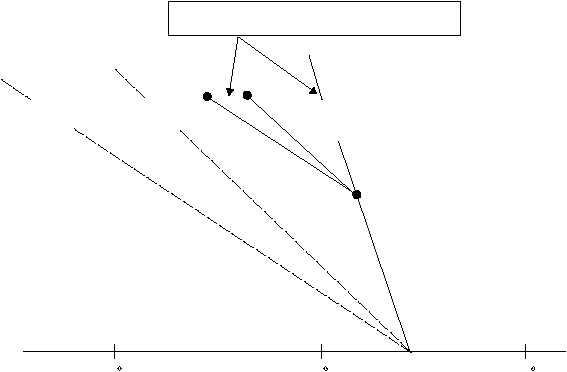If the parcel at point A were displaced upward to point
B, it would cool at the dry adiabatic lapse rate; and upon
arriving at point B, it would be colder than the
surrounding air. It would, therefore, have a tendency to
return to its original level. Consequently, the column of
air becomes stable. From this, the rule is established
that if the actual lapse rate of a column of DRY AIR is
less than the dry adiabatic lapse rate, the column is
stable.
NEUTRAL STABILITY.—Consider a column of
DRY AIR in which the actual lapse rate is equal to the
dry adiabatic lapse rate. The parcel cools at the dry
adiabatic lapse rate if displaced upward. It would at all
time be at the same temperature and density as the
surrounding air. It also has a tendency neither to return
to nor to move farther away from its original position.
Therefore, the column of dry air is in a state of
NEUTRAL STABILITY.
Equilibrium of Saturated Air
When saturated air is lifted, it cools at a rate
different from that of dry air. This is due to release of
the latent heat of condensation, which is absorbed by
the air. The rate of cooling of moist air is known as the
saturation adiabatic lapse rate. This rate is used as a
reference for determining the equilibrium of saturated
air.
ABSOLUTE STABILITY.—Consider a column
of air in which the actual lapse rate is less than the
saturation adiabatic lapse rate. The actual lapse rate is
to the right of the saturation adiabatic lapse rate on the
Skew T diagram (fig. 2-12). If the parcel of saturated air
at point A is displaced upward to point B, it cools at the
saturation adiabatic lapse rate. The air upon arriving at
point B becomes colder than the surrounding air. The
layer, therefore, would be in a state of ABSOLUTE
STABILITY.
From
this,
the
following
rule
is
established: If the actual lapse rate for a column of air is
less than the saturation adiabatic lapse rate, the column
is absolutely stable and the parcel would return to its
original position. Dry air cools dry adiabatically and is
also colder than the surrounding air. Therefore, this rule
applies to all air, as is evidenced when an unsaturated
parcel of air is displaced upward dry adiabatically to
point B. Here, the parcel is more stable than the parcel
displaced along a saturation adiabat.
INSTABILITY.—Consider now a column of air in
which the actual lapse rate is greater than the saturation
adiabatic lapse rate (fig. 2-13). If a parcel of moist air at
point A is displaced upward to point B, it cools at the
2-18
AG5f0212
-10
0
10
B
B
SATURATION
ADIABATIC
LAPSE
RATE
DRY
ADIABATIC
LAPSE
RATE
ACTUAL
LAPSE
RATE
1
POINTS B (DRY ADIABATIC) AND B (MOIST ADIABATIC)
WARMER THAN SURROUNDING AIR
1
A
Figure 2-12.—Absolute stability (any degree of saturation).


